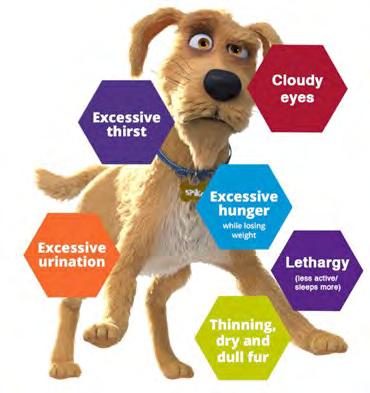
3 minute read
Diabetes Management in Pets

Diabetes (Diabetes Mellitus) in pets is a relatively common condition, caused either by a lack of insulin within the body, or the body's inability to respond to it. Insulin is an important hormone which allows cells to take in and utilise glucose, so with diabetes the glucose (blood sugar) levels increase in the blood. Once the levels are high enough, glucose will also appear in the urine. Unfortunately, diabetes cannot be cured, but it can be managed. The first clinical sign of diabetes in pets is usually an increasing thirst, which results in them peeing more, they usually become more lethargic and often have weight loss. Left untreated, diabetes can lead to a much more serious condition called ‘diabetic ketoacidosis’, this is when a product called ketones builds up in the body as the cells directly utilise fats for energy as they are not able to get the energy from blood sugars. Ketones in large number are extremely dangerous and cause vomiting, diarrhoea, anorexia (off food), ataxia (appearing unsteady), sometimes even causing collapse. In this state some people can smell a sweet acetone smell on their breath. Diabetic ketoacidosis is a condition which requires emergency treatment.
Advertisement
The diagnosis of this disease is done via blood & urine tests. Diabetes is a condition that needs lifelong treatment and a lot of commitment, especially in the early stages as your pet is stabilised. However, once treatment has started, your pet is likely to start to feel much better within a week or two.
Simple diabetics will start on insulin injections, however pets with more severe diabetes or if they develop ketoacidosis may require a period of hospitalisation including intravenous fluids. We will discuss your pet's treatment in depth with you to enable your pet to have a happy, healthy life.
and shouldn’t have treats between meals (because the extra food will cause a rise in blood sugar). Certain foods are better for diabetic pets because they release sugars slowly –we can advise you on these.
Most diabetic pets need twice daily injections of insulin, at set times, 12hours apart. They should be given within an hour of feeding (ideally just before, or at the same time as your pet eats). Your vet will show you how much insulin to give and how to inject it. Treating a diabetic pet can feel daunting to begin with, and most owners worry about injecting, making a mistake or feeding incorrectly. So, what could go wrong? You might accidentally inject too much or too little insulin or it may squirt out as you inject. Your pet might not eat all their food, or they might steal some extra food, or they might vomit after they’ve eaten - If you’re faced with any of these situations, call your us for advice. Managing diabetes is a partnership between us – we will always be on the end of the phone to help and give advice. Injecting may seem scary at first but it’s something you (and your pet) will quickly get used to; the needles are so small that some pets don’t even notice their injections! If you re unsure about anything to do with injecting, speak to us for advice, you can even come and see our nurses who will assist you until you become confident! In addition to keep your pet s blood sugar levels as steady as possible, you will need to feed them twice a day, at set times, 12 hours apart. They will need the same amount and type of food every day
As with diabetic people, we monitor diabetic pets regularly. Owners are encouraged to keep a diary of their pet’s food habits, drinking, exercise, behaviour, and demeanour, which also helps to give us a full picture of whether the diabetes is stable or not. A glucose curve can be used to give an even better idea of what a pet’s blood glucose levels are doing over a day and can help us see when any highs and lows are occurring - traditionally this involves a series of blood samples usually taken over an 8–12hour period. We tend to do these during the initial stabilisation of a diabetic patient, or when we think there is poor control of blood glucose levels. We often now use glucose monitoring devices, which attach to the pet's skin and can be read electronically, allowing these curves to be produced at home.
Animals with diabetes can lead a happy and normal life if the diabetes is well controlled, however complications of diabetes can include development of cataracts, and pets can be more prone to urinary tract infections. Treating a diabetic pet can take a lot of commitment and hard work and can be costly over their lifetime. If you’re worried about the costs or practicalities of looking after your diabetic pet, speak openly to us about your concerns. We will talk to you about what you think is right for your pet, your lifestyle, finances, and how you’ll think you’ll cope, we are here to support you and your pet every step of the way.
We are now accepting new clients, if you would like to register your pets with us, please give the team a call on 01603 783920.








David Martin BVM&S MRCVS







